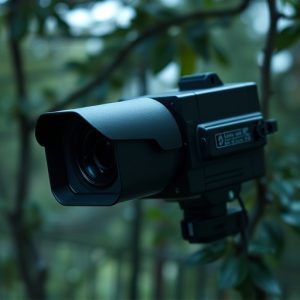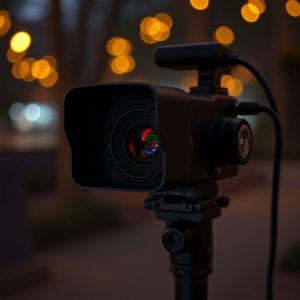Unveiling Hidden Surveillance: Common Spots & Detecting Invisible IR Cameras
Invisible IR cameras have revolutionized home security by offering discrete surveillance in complete…….
Invisible IR cameras have revolutionized home security by offering discrete surveillance in complete darkness, outperforming traditional cameras. Strategically placed in high-traffic areas like kitchens and bathrooms or disguised as everyday items, they provide advanced protection against intruders. However, their covert nature raises ethical and legal concerns, with varying penalties for unauthorized use. To counter these hidden devices, specialized infrared (IR) cameras and radio frequency (RF) detectors can reveal heat signatures and specific frequencies. Alternative solutions like smart home systems with motion-activated floodlights and wireless door/window sensors offer comprehensive security without compromising privacy.
Uncover the insidious world of hidden surveillance devices, where technology has enabled unseen eyes to watch our everyday lives. This article explores the advanced Invisible IR Camera technology that allows devices to operate without detection, revealing common spots these cameras hide in your own home. We’ll delve into ethical and legal implications, provide tips on detection, and offer alternatives for effective home monitoring, ensuring you’re informed about this critical issue in today’s digital era.
- Understanding Invisible IR Camera Technology
- Common Spots for Hidden Surveillance Devices in the Home
- Ethical Considerations and Legal Implications of Hidden Cameras
- Detecting Hidden Surveillance Devices: Tips and Tools
- Alternatives to Hidden Cameras for Home Monitoring
Understanding Invisible IR Camera Technology
Invisible IR cameras have revolutionized home monitoring by providing a level of security that was previously unattainable for many. These advanced devices are designed to capture high-quality images and videos in complete darkness, thanks to their infrared technology. Unlike traditional visible light cameras that rely on ambient lighting, IR cameras use infrared LEDs to emit light outside the human eye’s range, allowing them to capture detailed footage even in complete blackness.
This technology is especially useful for hidden surveillance, as it can be discreetly installed and operate without drawing attention. Invisible IR cameras are often used in strategic locations around a home, such as near entry points, corridors, or valuable assets. They offer a silent and invisible watchful eye, providing peace of mind and advanced warning against potential intruders.
Common Spots for Hidden Surveillance Devices in the Home
In the quest for discreet home monitoring, many turn to invisible IR cameras, unaware of their potential hiding spots within familiar environments. Common areas like kitchens and bathrooms often serve as strategic locations due to their high foot traffic and potential privacy vulnerabilities. These spaces offer easy access for installing devices that capture footage without drawing attention. Even seemingly innocuous items like light switches, smoke detectors, or fake fire alarms can double as concealment points for these advanced surveillance tools.
Ethical Considerations and Legal Implications of Hidden Cameras
The use of hidden surveillance devices, such as invisible IR cameras for home monitoring, raises significant ethical considerations and legal implications. Privacy is a paramount concern, with many individuals feeling that the installation of such devices constitutes an invasion of their personal space. Even if intended for legitimate security purposes, the mere presence of undetectable cameras can erode trust and foster a sense of paranoia within communities.
Legally, the use of hidden surveillance equipment varies by jurisdiction, with strict regulations in place to protect individual privacy rights. Unauthorized placement of cameras can lead to severe legal consequences, including fines and potential criminal charges. It’s crucial for homeowners considering invisible IR cameras to understand these legal boundaries and ensure their practices align with ethical standards, upholding both the letter and spirit of the law.
Detecting Hidden Surveillance Devices: Tips and Tools
Detecting hidden surveillance devices, often disguised as everyday objects, is a growing concern in the digital age. While some devices are advanced enough to evade standard searches, there are tools and techniques available for those determined to uncover them. One of the most common methods involves using specialized infrared (IR) cameras designed to detect heat signatures, which can reveal hidden electronic components that emit distinct thermal patterns. These IR cameras are particularly effective in identifying invisible IR cameras used for home monitoring, as they can capture visual evidence that regular light cameras cannot.
Additionally, radio frequency (RF) detectors and signal analyzers can be employed to locate wireless devices transmitting data. These tools can help identify frequency ranges associated with specific surveillance equipment, allowing users to narrow down their search and employ more targeted countermeasures. It’s crucial to stay updated on the latest technology used for hidden surveillance and keep these tips in mind: regularly inspect common spots like door frames, light fixtures, and wall sockets; use long-range sensors to check hard-to-reach areas; and consider professional services that specialize in electronic device detection for comprehensive assessments.
Alternatives to Hidden Cameras for Home Monitoring
While hidden surveillance devices have their place in home security, there are alternative options that offer enhanced visibility and peace of mind. An Invisible IR Camera, for instance, provides advanced home monitoring without compromising aesthetics or privacy. These cameras utilize infrared technology to capture clear images in low-light conditions, making them ideal for unassuming placement.
Instead of relying on hidden devices, consider installing smart home security systems that integrate with existing lighting fixtures, such as motion-activated floodlights. These not only deter potential intruders but also offer natural illumination during the day. Additionally, wireless door and window sensors can be discretely placed to alert you of any unauthorized access attempts, providing a more comprehensive safety network without the need for hidden cameras.
Hidden surveillance devices, particularly advanced invisible IR cameras, pose complex ethical and legal questions. While they offer enhanced home monitoring through features like infrared technology that captures unseen details, their secretive nature raises privacy concerns. As we’ve explored the common spots where these devices are hidden, it’s crucial to balance security needs with the right to privacy. Understanding the implications and employing tools for detection is essential to ensuring a safe yet respectful living environment. Alternatives to hidden cameras can provide a more transparent and ethical solution for home monitoring.


